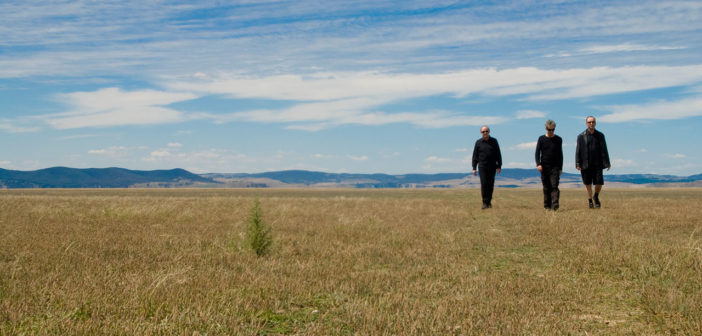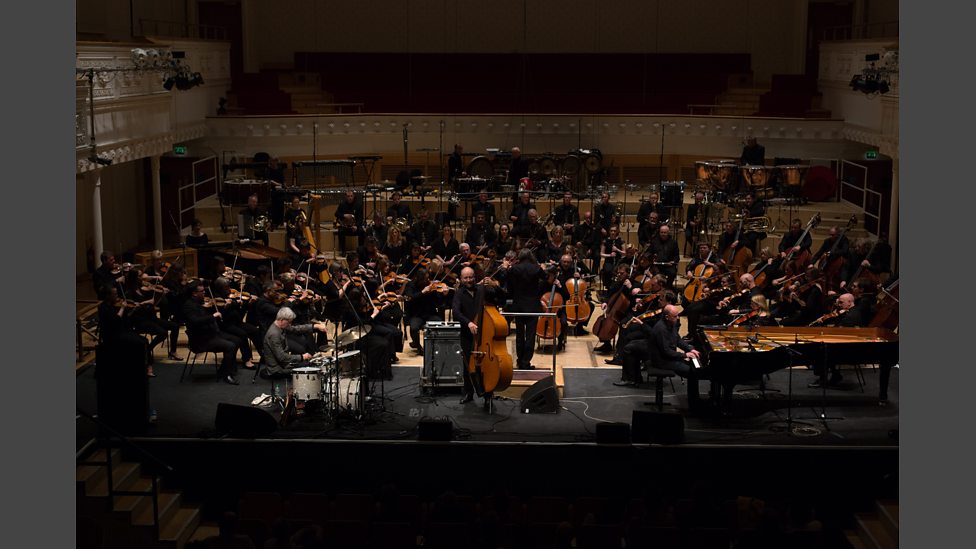The Necks have had a bumper 2017, touring Australia and the world extensively, collaborating with international conductor Ilan Volkov and the Adelaide Symphony Orchestra at Tectonics at the Adelaide Festival in March on Elemental, and the BBC Scottish Symphony Orchestra at Tectonics in Glasgow in May, selling out the first pressing of their new double vinyl album Unfolded, and playing a triumphant two sets at the Sydney Vivid Festival in what is now their home venue, the Sydney Opera House, in June. This is part of an extensive June Australian tour in which they play QPac in Brisbane, 4 nights at the Melbourne International Jazz Festival in the Jazzlab, Nexus Arts in Adelaide, the Rosemount Hotel in North Perth, the Darwin Entertainment Centre (a first for them), and the Bundanoon Trust in Ilaroo NSW. Later in the year they play festivals in Mulhouse, France, Saalfelden, Austria, Kristiansand, Norway and Aarhus, Denmark. And if this wasn’t enough, it comes on the heels of a UK tour in May where they played a sold out gig in Brighton, described by Eddie Myer in UK jazz magazine Jazzwise as ‘ministering to their flock … the crowd disperses into the night, like parishioners at the end of another successful service’. They also collaborated with Eddie Provost (formerly percussionist of legendary UK experimental jazz trio AMM) in Glasgow in his work Spirals, played at the Jazz Café in London and de Singer in Belgium, along with April gigs at the Cheltenham Festival and a sold out gig at the Bray Jazz Festival in Ireland. In February they did an extensive tour of the USA, and in January an Australian tour supporting Nick Cave and the Bad Seeds, in which they played for just under an hour to a largely attentive audience of Cave fans who filled the huge new ICC theatre in Darling Harbour for the Sydney Festival.
The Necks with Ilan Volkov and the BBC Scottish Symphony Orchestra at Tectonics in Glasgow, described by David Kettle as ‘kind of like Steve Reich meets Sigur Rós. The result was a slowly changing, monolithic wall of sound, across about an hour, which felt deeply satisfying on several levels: as a piece of music, as a process in action, and as an exercise in orchestra-wide improvisation, led by an alert Volkov on the podium, responding to the trio’s musical gestures’.
As Lloyd Swanton told Stephen Adams of the ABC Adelaide program Waves in March, prior to a recording of Elemental, they have ‘hit a purple patch’ and are no longer ‘an overnight sensation’ on the other side of the world, where they also played a gig in May in La Dynamo in Paris, and three more in the Czech Republic, in the Akropolis in Prague, the Jazz Tibet in Olomouc, and the Národní dům in Usti Nad Labem. Lloyd Swanton and Chris Abrahams gave an interview prior to and after Elemental, a 40 minute piece in which they played with Speak Percussion and the Adelaide Symphony Orchestra, who are no strangers to unconventional collaborations, having played their Restrung gig with hip hop group the Hilltop Hoods in 2009 and again in 2016, this time to a crowd of 12,000, in what Luke Griffiths in the Adelaide Advertiser described as in a state of ‘utter adoration’. That probably wouldn’t quite describe the response to the Necks, but ‘mesmerised’ would be closer to the mark. And not forgetting the ever-experimental BBC Scottish Symphony Orchestra, who in 2009 played Tchaikovsky’s Violin Concerto in D Major Op. 35 with eccentric Australian violinist Jon Rose improvising. (Rose was again on hand at Tectonics in 2016 with his remodelled violin.)
Swanton explained that the Israeli-born conductor Ilan Volkov, who has been resident in the UK for many years, has also worked with the Iceland Symphony Orchestra, and runs the Tectonics festival around the world, first approached the Necks with the idea, and they had a few Skype discussions. The Necks were enthusiastic, as Volkov had a sound knowledge of their work, and Tony Buck created 10 graphic representational designs for the percussion, while Swanton created four charts for strings. With an orchestra of 50-60 musicians, the work had to be structured in order to avoid total chaos, and the Necks had to forgo some of their strict rules of free improvisation with no rehearsals. As it was, they only had two rehearsals with the Adelaide Sympomy Orchestra, in which they explained and demonstrated how their music works, and found that the orchestra were quick to pick it up. Volkov acted as a conduit between band and orchestra, ‘like a painter’, as Swanton said, using hand signs and placards, while the members of the orchestra had cue sheets, and the final performance took place in the Adelaide Town Hall. The result begins with Swanton playing a series of glissandos on his bass, with Buck eventually joining in on percussion, in what Swanton has described as an ‘octopoid, four-limbed approach to the drumkit’, and Abrahams playing a series of piano figures. Gradually they are joined by flutes and other bird-like sounds from the orchestra, with metallic-sounding percussion, surging brass, and thrumming strings developing into pizzicatos, with Abrahams playing piano swirls, playing above the orchestra in what Adams described as ‘almost like a piano concerto’, although Abrahams, ‘utterly focused on the process’ as Swanton puts it, denied having any knowledge of this, preferring to remain completely intuitive and unconscious of any exterior perspective. The work rises to a gradual crescendo, as do the Necks’ live gigs generally, with Abrahams playing a series of staccato-like chords, with percussion prominent behind him, before ending without fanfare. Elemental’s performance with the Scottish Symphony Orchestra was also recorded by the BBC (now expired), and it is hoped that this operation will be repeated in the future, although Swanton has stated that the copyright complications involved will probably inhibit any permanent recording of the event.
Back at work as a trio in the Sydney Opera House, the Necks played their customary two sets to rousing cheers from the audience, by now totally familiar with their work. The first set was begun by Abrahams, playing a right hand figure, with Swanton playing arco bass then changing to a percussive sounding plucking of the strings, while Swanton scraped a cymbal over the tom and hit the bass drum, also playing a tiny drum on a string. Things meandered for a while, reminding me of Swanton’s comments that the trio has played together so many times now that they never panic, always remaining calm if they hit a ‘dull patch’, relying on at least one of them to get them out of it without resorting to anything major or dramatic. Another thing Swanton mentioned was the stamina of his fellow musicians, who have to maintain an often repetitive rhythm for an often considerable amount of time. Eventually they hit a groove, and slot into their gradual crescendo, ringing often infinitesimal changes, and finishing with a flourish. Buck begins the second set with his scraped cymbal, and they hit a groove sooner this time, all guns blazing. Often it’s hard to distinguish which sound is coming from which instrument – there’s an almost synesthesic sense to the collective sound the group makes, and this happens in this case. The piece ends with a final melodic flourish from Abrahams, and that’s it in Sydney for another year, although a very busy one in 2017, with little time left over for the individual members to pursue their own projects.





